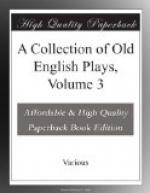[51] 4to. Form.
[52] 4to. adorning. Possibly there is the same confusion in Antony and Cleopatra, ii. 2:—“And made their bends adornings.”
[53] See notes of the commentators on Hamlet, i. 1, 165, “Then no planets strike.”
[54] See the commentators on As You Like It, iii. 2. “I was never so be-rhymed since Pythagoras’s time that I was an Irish rat.” A short time ago the subject of “rhyming rats to death” was discussed anew in “Notes and Queries.”
[55] Qto. cockfromb in cony. The word “incony” (meaning sweet, delicate) occurs twice in Love’s Labour Lost. Its derivation is uncertain.
[56] 4to. With.
[57] This word is found in Holland’s “Ammianus” and Harrington’s “Epigrams” (see Nares’ “Glossary,” ed. Halliwell). A similar compound (of more common occurrence) is “smell-smock.”
[58] The reader will remember the punning lines in 3 Henry VI., v. 1:—
“Why, what a peevish
fool was that of Crete,
That taught his son the office
of a fowl!
And yet, for all his wings,
the fool was drown’d.”
[59] 4to. Wilt it.
[60] 4to. Flor.
[61] A perfume-ball worn round the neck or carried in the pocket.
[62] The trials of the Scotch witches in 1590 (for practising to shipwreck James VI. on his return with his bride from Denmark) were too horrible to be soon forgotten.
[63] 4to Ape.
[64] Quy. cliffe.
[65] I suspect that we should read—
“What rock hath bred
this savage-minded man
That such true love
in such rare beautie shuns?”
[66] 4to. clime.
[67] Quy. lead.
[68] 4to. Alp.
[69] Vide note on vol. I, p. 117.
[70] The direction in the 4to is “Enter Flores and Homer!”
[71] Vide note [16].
[72] 4to. craines.
[73] Compare Midsummer Nights Dream, ii. 1, 15: “And hang a pearl on every cowslip’s ear.”
[74] 4to. where.
[75] Not marked in the 4to.
[76] 4to. rake.
[77] 4to. Sorrowed tired.
[78] The 4to prints the lines thus:—
“Where since he found
you not,
He asked of me the place of
your abode,—
And heere I have brought him?”
In other passages I have restored the metre silently.
[79] Qto. visition.
[80] I regret to say that Mr. Fleay was misled by a mistake of mine. In my first hasty reading of the play I took the long double “s” to be a double “f”: the character is “La Busse.”
[81] Mr. C.H. Herford, to whom I showed the MS., writes as follows:— “The first two words make it highly probable that the whole inscription is, like them, in Italian. In that case the first two Greek letters give very easily the word ‘fidelta’ (=_phi, delta_), which combines naturally with the nella. The second part is more difficult, but perhaps not hopeless. [Greek: fnr] may, perhaps be read phi ny (as Latinised spelling of [Greek: nu]), ro, or finiro. Then, for the ‘La B.,’ suppose that the words form, as emblems often do, a rhymed couplet; then ‘B.’ would stand for Belta, and naturally fall in with ‘la.’ The whole would then read—




